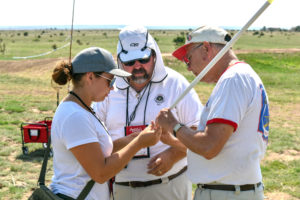Super-Roc Altitude
 OVERVIEW
OVERVIEW
For the full rules for this event, please see the Super-Roc Altitude rules in the Model Rocket Sporting Code.
SCORING
Each flight is scored separately. Each flight is scored as the length (within the limits) times the altitude. This makes for some situations where motor availability will dictate minimum length models or maximum length models.
GENERAL TIPS
Many rocketry vendors now sell tubes in 36 inch lengths, along with coupler stock that is also 36 inches long. Good Super-Roc models typically use minimum diameter tubing with very long couplers to bridge multiple sections of tube. Some modelers use glue, ‘blackshaft’ tubing, or tape to reinforce the lengths of tube. Another trick is to add coupler sections every few inches inside the model, which can make it stronger.
It is a good idea to simulate various lengths of Super-Roc and calculate the score to see if you should build for minimum length, maximum length (or build both and try).
Some models that fly fine in no wind will crimp in higher wind. Be aware of the flying conditions!
Recent R&D work has shown that Super-Roc crimping can be caused by aeroelastic divergence. A new computer program called FlexRoc can be used to estimate the failure speed of Super-Roc models. See the article by Chris Flanigan for more information.

MOTOR SELECTION
For most events, single motors work best. Like most altitude events, low thrust motors will usually produce higher altitudes than high thrust motors, but the models can be heavy enough that they need some ‘oomph’ to get off the pad. There are events where clustering several motors can be advantageous if there are no good motors available, such as using two F10 motors for G Super-Roc Altitude.
KITS
No-Crimp kits (A through D) by Qualified Competition Rockets
Tall Boy by Aerospace Speciality Products
Related Documents:
| Avoiding_the_Bends | August 11, 2014, 8:08 pm | 553 KB |